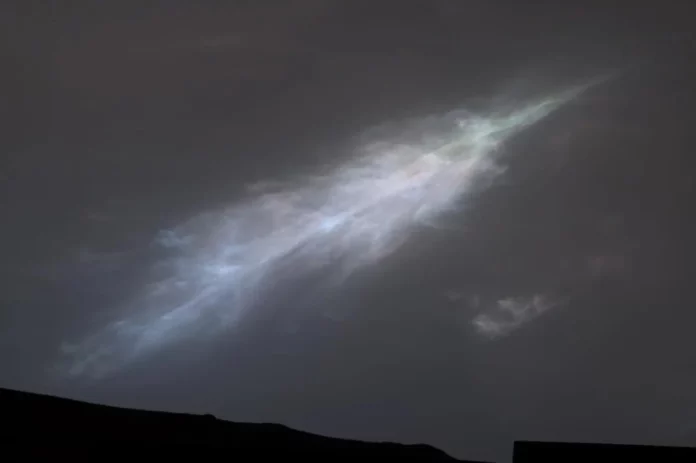And now for something completely different: NASA‘s Curiosity rover captured a feather-shaped cloud glowing in the Martian sky shortly after sunset on the Red Planet.
The image is dated January 2023, but NASA recently published it in a newsletter dedicated to the rover’s exploration of the planet’s sky last month.
During this study, Curiosity took images for 16 minutes on January 17, or Sol 4426 on Mars. The images show reddish-green clouds in the Martian twilight. These clouds are nictitating (or “night glow”) clouds caused by the way sunlight scatters in the dusty Martian atmosphere.
According to NASA, Martian clouds are composed of either water ice or carbon dioxide. Only the clouds of the latter group – which occur at higher altitudes and lower temperatures than water ice clouds – glow as shown in the figure above. Nighttime clouds occur on Mars at an altitude of about 37 to 50 miles (60 to 80 kilometers) above the surface. When the clouds drift much lower (below 31 miles or 50 kilometers), they evaporate due to the rising temperature in the atmosphere.
Nighttime clouds are not just an extraterrestrial phenomenon. Rocket launches on Earth can cause glowing clouds to appear in the upper layers of the Earth’s atmosphere, which can only be seen shortly after sunset or before sunrise – at other times, they are too bright to see.
Clouds on Mars come in many shapes and sizes. In 2022, ESA scientists spotted clouds in the Red Planet’s sky that were very similar to those forming on Earth. The following year, the Perseverance rover encountered heavy cloud cover – a sign of cloudy days ahead in a dusty, distant world. The newly photographed rainbow clouds are not a newly discovered phenomenon, but they are still mesmerizing to look at – and still need to be carefully studied.
Twilight clouds were first seen on Mars by NASA’s Pathfinder spacecraft in 1997. Curiosity didn’t repeat this trick until 2017, and last month the rover spotted the clouds for the fourth time in its year on Mars.
At the end of last year, NASA researchers published a study in the journal Geophysical Research Letters, in which they described how the rainbow effect shows how ice forms and grows in the Mars atmosphere.
“I’ll always remember the first time I saw these rainbow clouds and at first I was sure it was some kind of colored artifact,” said Mark Lemmon, an atmospheric scientist at the Colorado Institute of Space Sciences and lead author of the study, in a NASA release. “It has now become so predictable that we can plan our imagery in advance; the clouds appear at exactly the same time of year.”
The release notes that these clouds have not been seen by rovers in other parts of Mars. It is possible that the region Curiosity is exploring – Mount Sharp in Gale Crater – may be suitable for hosting clouds.









